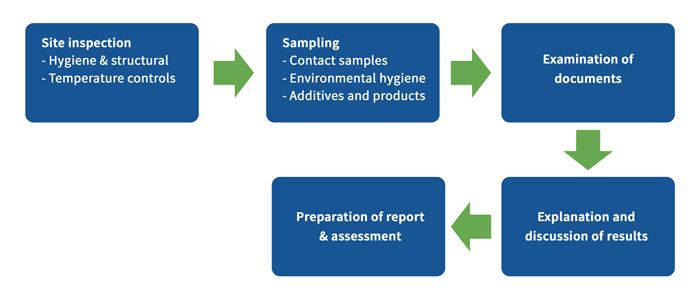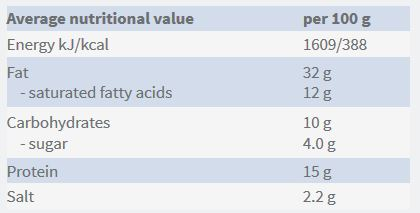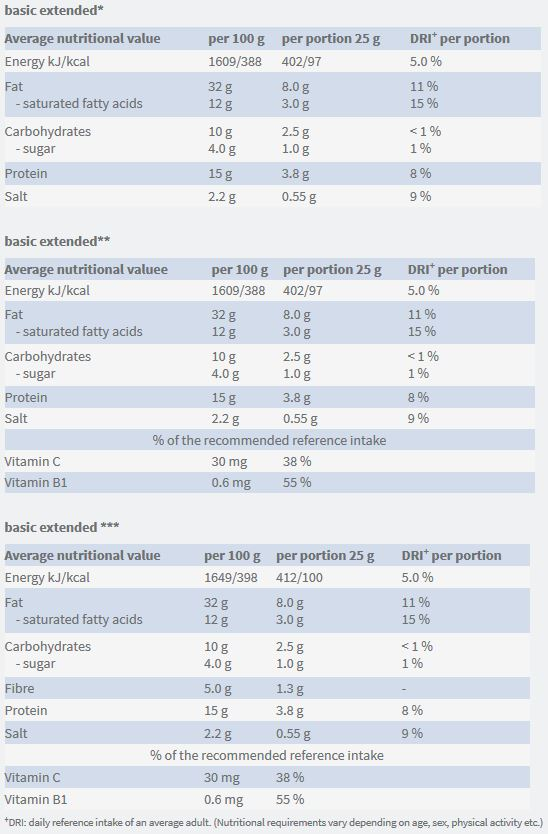Nutrition declaration according to Food Information Ordinance
The nutrition table provides consumers with all the important information about the nutritional composition of food, enabling them to compare products with each other.
Since 13.12.2016, the nutrition declaration has been one of the mandatory labelling elements for pre-packaged foods. This is regulated at European level by "Regulation (EU) No. 1169/2011 of 25 October 2011 on the provision of food information to consumers" (Food Information Regulation - LMIV).
Mandatory information (BIG7)
The mandatory data per 100 g (ml), also referred to as BIG7, shall normally be presented in the form of a table. It must contain energy in kilojoules (kJ) and kilocalories (kcal) and fat, including saturated fats, carbohydrates, including sugar, protein and salt.The energy value and nutrients shall be given in the order given in Annex XV to the LMIV.
Example of mandatory labelling according to LMIV:
| Average nutritional values | per 100g |
| Energy kJ/kcal | 1609/388 |
| Fat - of which saturated fatty acids |
32g 12g |
| Carbohydrates - of which suga |
10g 4,0g |
| Protein | 15g |
| Salt | 2,2g |
Optional data and exceptions
In addition to the mandatory information, further nutrients may be declared on a voluntary basis. Monounsaturated or polyunsaturated fatty acids, polyhydric alcohols, starch, fibre and vitamins and minerals present in significant quantities may be listed. The order of the information in Annex XV of the LMIV should be observed. The calorific value and the nutrient quantities may also be given as a percentage of the reference quantities laid down in Annex XIII of the LMIV.
Not every food requires a nutrition declaration. Annex V of the LMIV contains a list of foods exempted from the mandatory nutrition declaration. These include unprocessed products consisting of only one ingredient, herbs and spices, coffee, tea and foodstuffs in packaging with a maximum surface area of less than 25 cm².
In addition, the information per portion or per unit of consumption can also be given in the sewing value table.
Tolerances and rounding guidelines
Nutrient claims are average values, as food is subject to change due to natural variations, seasonal influences in the cultivation, transport and storage of ingredients and food. However, nutrient levels should only vary within certain limits.
The European Commission has therefore published a guide for competent authorities to monitor compliance with EU legislation. This document provides guidance on tolerances and rounding guidelines for the declaration of nutritional values or vitamins and minerals.
The ifp Institute for Product Quality carries out state-of-the-art nutritional analyses. Our team supports you in preparing the nutrition declaration of your products. Please do not hesitate to contact us.
Sensory analysis in the quality assessment of foodstuffs
The sensory properties of foodstuffs have become an increasingly important quality criterion in recent years. Sensory analysis involves scientific tests which investigate the link between products (ingredients, constituents, packaging materials) and their perception and evaluation by the human senses.
Areas of application in the food sector include:
- Product development
- Quality improvement/quality control
- Checking minimum shelf life
- Assessing packaging and packaging materials
Our services for the food industry
Our services include the following sensory tests:
- Simple descriptive test
- Ranking tests
- Triangular test
- Inspection of minimum shelf life of foodstuffs
Sensory analysis at the ifp: state-of-the-art premises, trained inspectors
The ifp Institute for Product Quality has a sensory analysis room equipped in accordance with ASU L 00.90-2:2015-06. This includes a preparation area, an area for group investigations as well as a separate room with eight booths for individual testing and training.
Our inspectors are selected on the basis of their sensory skills. Regular internal aptitude tests comprising recognition tests, ranking tests, triangular tests and descriptive tests based on ASU L 00.90-10:2015-06 ensure the consistent quality of the sensory tests. In addition to this, product-specific knowledge is constantly updated through separate training.
Please feel free to contact our experts if you have any further questions.
Ask our specialists about sensory. Get in contact with us.
Food Analytics
When it comes to food analysis, ifp offers its expertise by providing a broad range of analytical services. The combination of expert staff, state-of-the-art laboratory equipment and products specifically developed by ifp guarantees high-quality analyses and competent service.
|
|
||
|
|
||
|
|
||
|
|
||
|
|
||
|
|
||
|
|
||
|
|
||
Hygiene management for manufacturers, kitchens and catering
The term “hygiene” (Greek: hygieia - health) can be translated as health care or the science of preserving health. Hence, hygienic measures are preventive measures with the aim of protecting health. According to the Codex Alimentarius, the term “food hygiene” encompasses “all conditions and measures necessary for the extraction, processing, storage and distribution of food to obtain a product, which is not harmful to health (safe), healthy and easily digestible and thus suitable for human consumption”.
Professional hygiene management: the best way to prepare for official food inspections or certification audits
Anyone who places food products onto the market is obliged to ensure the safety of those products. The requirements that apply to manufacturers, industrial kitchens, caterers, etc. have become stricter through a series of EU Regulations introduced from 2002 to 2005. Benefit from our experience in dealing with authorities, inspection bodies and certification bodies as the optimal preparation for audits. Our systematic, functional and complete hygiene management comprises:
- Hygiene inspections service
- Review of QM systems as well as of HACCP concepts and documents
- Review of environmental hygiene and air hygiene
- Sampling and microbiological analysis of raw materials and product samples
Hygiene inspections for producers, kitchens and caterers
During an inspection, the food company’s premises, processes and documents are checked for compliance with statutory requirements, guidelines and standards regarding hygienic and structural requirements.
- Consultation and specification of the inspection programme, taking into account focus areas (hygiene, construction, pathogen monitoring) as applicable.
- Inspection along the manufacturing chain including sampling
- Staff hygiene, process hygiene and food hygiene
- Hygienic premises, devices and environment
- Cleaning and disinfection
- Traceability and in-house logistics
- Document review, especially of the HACCP and management system
- Preparation of a report listing non-conformities and relevant recommendations
- Issue of a certificate on request
Nutritional value
The team of analysts at ifp Institut für Produktqualität perform state-of-the-art nutritional value analyses.
Nutritional value labelling according to the Food Information Regulation
Nutrition labelling will be mandatory and subject to new regulations in future. Regulation (EU) 1169/2011 of 25 October 2011 concerning the provision of food information to consumers was proclaimed and published in the Official Journal on 22 November 2011. The Regulation came into force on 12 December 2011 and will be valid as of 13 December 2014. The obligation to declare the nutritional value (Articles 9, 30 and 32) will not be valid until 13 December 2016. Any nutrient labelling done voluntarily prior to this date must comply with the Regulation as of 13 December 2014. Up until then any nutritional information declared is voluntary. Despite this, the food-producing sector is already beginning to modify or state nutritional values in accordance with this Regulation.
Mandatory food information (BIG 7)
The mandatory nutrient declaration referring to 100 g (ml), also referred to as the BIG 7, is given in the form of a table: energy value in kilojoules (kJ) / kilocalories (kcal), fat, saturated fatty acids, carbohydrates, sugar, protein and salt.
Example: basic
Voluntary food information
The calorific value and nutrients can additionally be stated in percent of the reference intake for adults, as listed in Annex XIII, indicating “Daily reference intake for adults (8400 kJ/2000 kcal)”, see Article 32.
Annex V of the Regulation contains a list of foods that are exempted from the requirement of mandatory nutrition declaration. These include unprocessed products that comprise a single ingredient, coffee, tea, foods that are directly supplied by the manufacturer of small quantities, and food in packaging the largest surface area of which is less than 25 cm².
All definitions of terms are found in the Regulation.
Examples:
Tolerances and Rundungsleitlinien
The EU has published a guidance document for competent authorities for the control of compliance with EU legislation. This document contains information on tolerances and rounding guidelines for the declaration of nutritional values, vitamins and minerals.











 Intolerances
Intolerances








